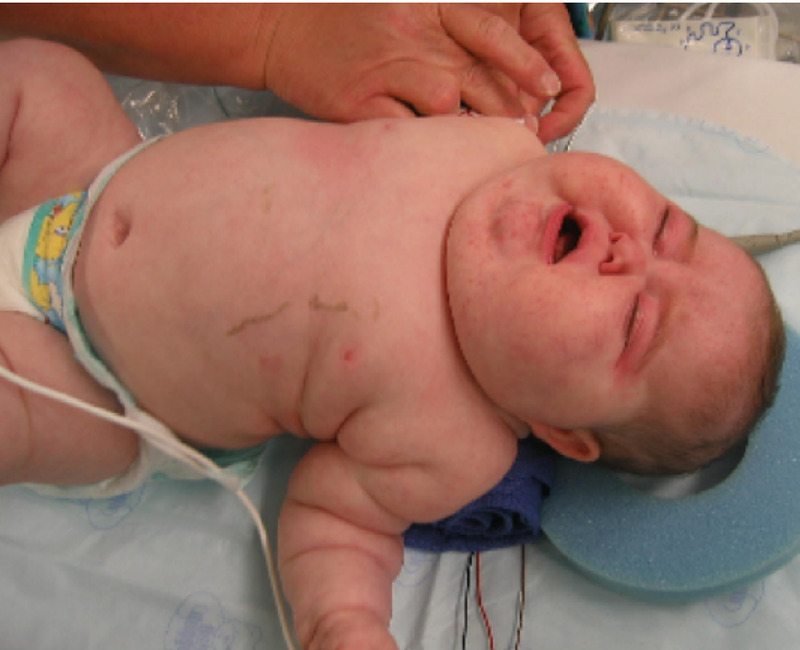Playlist
Show Playlist
Hide Playlist
Cushing's Disease and Syndrome – Secondary Hypertension
-
Slides Secondary Hypertension.pdf
-
Reference List Nephrology.pdf
-
Download Lecture Overview
00:01 So, Cushing's syndrome is a clinical condition that results from excess effects of either exogenous, meaning that I'm giving glucocorticoids, or endogenous glucocorticoids. 00:12 Exogenous glucocorticoid administration includes things like medications. 00:18 Endogenous glucocorticoid excess includes things like pituitary secretory adenoma or Cushing's disease, ectopic ACTH production, perhaps from a tumor, or a functional adrenal adenoma. 00:33 So, the way our patients typically manifest is they will have very classic physical exam signs like centripetal obesity, fat deposition in the face, neck, and trunk of an abdomen. 00:46 They can have what we call a moon facies, so fat accumulation in the cheeks and temporal fossa, or they can have skin atrophy and abdominal striae, so these are these broad purple streaks due to fragile skin and underlying venous blood flow in the dermis can be seen. 01:03 Patients can also have acne and hirsutism. 01:07 So, that's increased hair on the upper lip and chin due to androgen excess. 01:12 They might complain of promixal muscle weakness. 01:15 They'll have hypertension and glucose intolerance. 01:19 So, once we have that patient sitting in front of us, we want to do a biochemical confirmation that they do, in fact, have Cushing's syndrome or Cushing's disease. 01:31 So, the next step that we can do is obtain a 24-hour urine cortisol excretion. 01:36 We're looking for a positive result which would be greater than threefold the upper limit of normal. 01:42 Now, I want you to keep in mind that you can have some false positives, particularly in women who might have polycystic ovarian syndrome. 01:50 Another test that we can do is a late-evening salivary cortisol level. 01:56 It should be elevated in Cushing's. 01:58 And finally, a low-dose dexamethasone suppression test. 02:04 So, dexamethasone, I want you to think about, really substitutes for endogenous cortisol. 02:08 It suppresses ACTH. 02:11 That suppression of cortisol secretion then, should decrease that serum cortisol level. 02:16 What we do is we give our patients a 1-mg dose of dexamethasone. 02:20 It's taken at midnight and then we measure plasma cortisol levels in the morning at 8 AM. 02:26 A level of less than 50 nmol/L is normal and that's what our patient should have if they do not have Cushing's disease or syndrome. 02:34 If their cortisol is still elevated despite the fact that we gave them an agent that should suppress cortisol production like dexamethasone, that patient has biochemical evidence of Cushing's syndrome or Cushing's disease. 02:46 Now, for patients who have a high index of suspicion, 2 out of 3 of these tests are needed for biochemical confirmation. 02:54 Now, we're not finished yet. We have to decide where is this coming from. 02:59 So, it's gonna be important to do a few different imagining modalities. 03:02 If we are suspecting Cushing's disease, that means that's a pituitary adenoma. 03:07 We want to obtain an MRI of the brain and we're looking for thin cuts through the sella turcica to identify that pituitary or ACTH adenoma in Cushing's disease. 03:17 If we're concerned about Cushing's syndrome due to an ectopic ACTH-producing tumor, then we wanna obtain a CT of the chest, particularly in a patient who might have risk factors for a malignancy or who have a known malignancy. 03:32 And finally, if we're suspect of a functional adenoma of the adrenal gland, we want to obtain a CT of the abdomen. 03:41 Again, we're looking for that adrenal gland having a cortisol-secreting tumor. 03:45 So, once we've located where our tumor is at, then we want treatment. 03:51 We want a surgical cure and we can do that in Cushing's disease where we have a pituitary adenoma. 03:56 We can have our neurosurgical colleagues come in and they do a transsphenoidal resection of that adenoma. 04:03 That's not that easy to do, so sometimes patients will also receive pituitary irradiation. 04:07 If our patient has an ectopic ACTH production due to a pulmonary tumor, then we can remove that or if they have an adrenal tumor, that's a functional adenoma, then we have our endocrine surgeon come in and do a laparoscopic surgical resection.
About the Lecture
The lecture Cushing's Disease and Syndrome – Secondary Hypertension by Amy Sussman, MD is from the course Secondary Hypertension.
Included Quiz Questions
Which of the following tests is used to screen for Cushing`s syndrome?
- 24-hour urinary cortisol
- High-dose dexamethasone suppression test
- Glucose suppression test
- Saline infusion test
- MRI of the pituitary
Which of the following statements is correct regarding Cushing`s syndrome?
- A 24-hour urinary excretion test may give false-positive results in polycystic ovary syndrome.
- A dexamethasone suppression test involves taking 1 mg of medication in the morning and measuring cortisol in the evening.
- A chest CT is the imaging modality of choice in suspected Cushing`s disease.
- Estrogen excess is the cause of acne and hirsutism seen in Cushing`s syndrome.
Which of the following is a treatment for Cushing's disease?
- Transsphenoidal resection of pituitary adenoma
- Renal vein sampling
- Renal artery stenting
- Endovascular aortic repair
Customer reviews
5,0 of 5 stars
| 5 Stars |
|
5 |
| 4 Stars |
|
0 |
| 3 Stars |
|
0 |
| 2 Stars |
|
0 |
| 1 Star |
|
0 |




